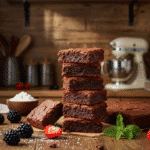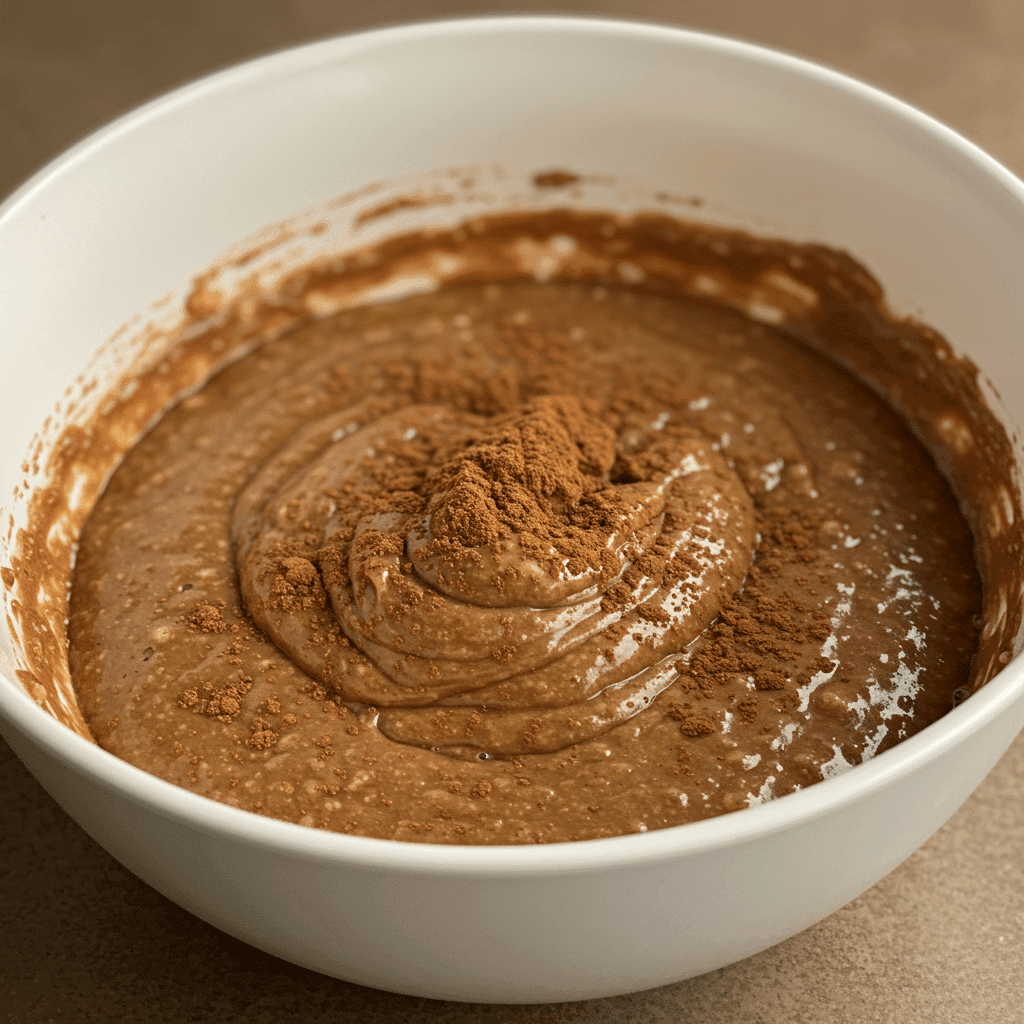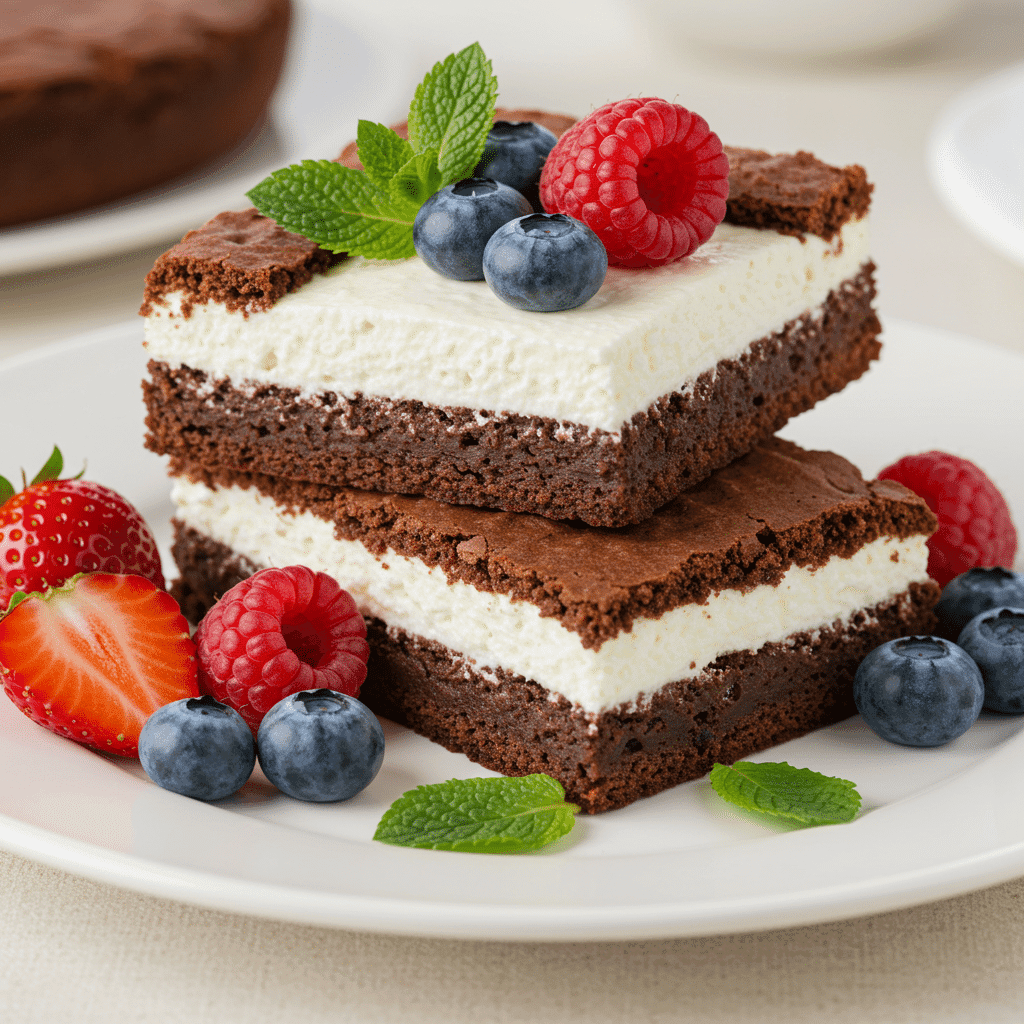If you’re wondering whether cottage cheese belongs anywhere near a brownie pan, I get it—I was skeptical too. But one bite of these rich, fudgy, protein-loaded cottage cheese brownies and you might never go back. In this post, we’re diving into how cottage cheese transforms basic brownies into something surprisingly satisfying. We’ll cover how it behaves in baking, whether you can use it to replace oil, and if it actually melts in the oven (spoiler: not how you’d expect). If you’re looking to bake something that hits that sweet spot between healthy and indulgent, these cottage cheese brownies might just become your new favorite.
Table of Contents
Why I Put Cottage Cheese in My Brownies
Brownies weren’t exactly something I made from scratch growing up. My kitchen skills were more “microwave the box mix and hope for the best.” But a few years ago, when I started paying more attention to ingredients, I realized how much sugar, oil, and filler goes into the boxed stuff. That’s when I started experimenting with ways to keep the rich, chocolatey texture—but lighten it up just a bit.
One night, mid-refrigerator raid, I spotted an open tub of cottage cheese left over from breakfast. It was a weird idea, but I’d already tried adding Greek yogurt to muffins with decent results. So why not? I blended it smooth, swapped it in, crossed my fingers… and holy fudgy miracle.
These weren’t just good for healthy brownies—they were seriously good. Fudgy, moist, and rich, but not greasy or overly sweet. I knew I had something worth perfecting. And just like that, cottage cheese brownies became a permanent part of my weekly baking rotation.
By the second batch, I realized I was onto something bigger than a one-time swap. These cottage cheese brownies didn’t just taste amazing—they gave me a way to satisfy chocolate cravings without loading up on butter or processed oils. That little tub of dairy completely changed how I approach dessert.
That first batch sparked a habit. I tested different cocoa powders, adjusted baking times, even threw in some peanut butter once. But the cottage cheese stayed constant. It’s now my not-so-secret ingredient, and it’s doing a lot more than just adding protein.
And let’s be honest—if something can make a brownie taste this rich while sneaking in nutrients, it deserves a permanent spot in the pantry. I’ve taken these cottage cheese brownies to bake sales, potlucks, and family dinners, and not once has someone guessed the main ingredient. Instead, they ask for the recipe. That’s always a good sign.
If you’re into experimenting with ingredients—or you’re simply tired of the usual oil-heavy recipes—this post will give you everything you need to make your own cottage cheese brownies at home.

A Pantry Surprise Turned Pantry Staple
When I first told a friend I was using cottage cheese in brownies, she wrinkled her nose and said, “Isn’t that…lumpy?” Valid concern. But here’s the trick: blend it. A quick blitz in the blender turns even the curdiest cottage cheese into a smooth, pourable mixture. And when it bakes into brownies? It gives them a melt-in-your-mouth texture that rivals butter—without the extra fat.
I’ve used this method to sneak more protein into weeknight treats, balance out indulgent desserts, and even surprise guests who never guess the secret. And if you’re trying to cook smarter (not harder), this trick slides beautifully into other kitchen routines. You could even pair these cottage cheese brownies with a scoop of creamy corn ice cream for a sweet-savory dessert that surprises people in the best way.
Cottage cheese might seem like an odd choice for baking, but if you give it a shot, you’ll see why it’s become a staple in my fridge—right next to my cocoa powder and almond flour. It’s cheap, packed with protein, and endlessly adaptable. And when it shows up in these brownies? Let’s just say there are rarely leftovers.
To round out a balanced meal, I often pair these with something from my high protein no sugar recipe collection—because cottage cheese brownies aren’t just dessert, they’re part of the plan.
Print
Cottage Cheese Brownies That Are Fudgy, Protein-Packed, and Shockingly Simple
- Total Time: 40 minutes
- Yield: 9 brownies 1x
Description
Rich, fudgy brownies made healthier with protein-packed cottage cheese—perfectly moist, indulgent, and secretly nutritious.
Ingredients
- 1 cup blended cottage cheese (full-fat or low-fat)
- 1/2 cup cocoa powder
- 1/2 cup flour (all-purpose or almond flour)
- 1/2 cup sugar or sweetener of choice
- 2 eggs
- 1/4 cup oil or more cottage cheese
- 1/2 tsp baking powder
- 1/2 tsp salt
- 1 tsp vanilla extract
- Optional: chocolate chips or chopped nuts
Instructions
- Preheat oven to 350°F (175°C) and line an 8×8 inch pan with parchment paper.
- Blend cottage cheese until smooth and creamy.
- In a large bowl, whisk eggs, sugar, oil, and vanilla together.
- Mix in the blended cottage cheese.
- Add cocoa powder, flour, baking powder, and salt. Stir until well combined.
- Fold in optional chocolate chips or nuts if using.
- Pour batter into prepared pan and spread evenly.
- Bake for 25–30 minutes, or until center is just set.
- Cool completely before slicing.
Notes
Blend cottage cheese thoroughly to avoid curds in the final texture. For extra fudginess, slightly underbake and let brownies set while cooling.
- Prep Time: 10 minutes
- Cook Time: 30 minutes
- Category: Dessert
- Method: Baking
- Cuisine: American
Nutrition
- Serving Size: 1 brownie
- Calories: 140
- Sugar: 6g
- Sodium: 160mg
- Fat: 7g
- Saturated Fat: 2g
- Unsaturated Fat: 5g
- Trans Fat: 0g
- Carbohydrates: 12g
- Fiber: 1g
- Protein: 7g
- Cholesterol: 40mg
Keywords: cottage cheese, brownies, healthy dessert, high protein, fudgy brownies
Baking Chemistry Behind the Creaminess
Can you put cottage cheese in brownies?
You absolutely can—and honestly, you should. Cottage cheese in brownies isn’t just some health hack from the internet. It genuinely improves the texture while sneaking in extra protein. When blended, cottage cheese becomes creamy and smooth, adding richness without the heaviness of butter or oil. In brownies, that means soft, dense, fudgy bites with a subtle tang that plays nicely with cocoa.
Think about what makes a brownie irresistible: moisture, depth, chew. Cottage cheese contributes to all three. It locks in moisture during baking, preventing the crumb from drying out. That’s especially helpful if you’re going lower on oil or skipping eggs. And because it’s packed with casein protein, it holds structure well—so your brownies won’t collapse like oil-heavy versions sometimes do.
If you’re curious whether cottage cheese brownies are just a trend, the answer is no. This swap has real culinary chemistry behind it. When the proteins in cottage cheese interact with heat, they help bind and stabilize the batter while creating that melt-in-your-mouth finish you usually only get with lots of fat. It’s smart baking, not just sneaky substitution.
And if you’re the type who meal preps snacks for the week, these brownies fit perfectly into a meal prep planning routine. They store well, travel well, and deliver both flavor and nutrition in every square. If you’re baking for kids or a picky partner, cottage cheese brownies are an easy win—they taste like dessert but deliver a subtle health boost that most won’t even notice.
What does cottage cheese do in baking?
In baking, cottage cheese functions as both a moisture source and a structural supporter. It steps in where ingredients like eggs, milk, or sour cream might otherwise go, offering a similar balance of protein and moisture. And the best part? It does this while cutting down on added fats.
Blended cottage cheese becomes a neutral base. It won’t overpower the chocolate flavor in your brownies, but it brings body to the batter. Instead of a thin, runny mix, you’ll notice your brownie batter has more heft and elasticity—which often results in a better rise and more even bake.
And if you’re skeptical about texture, don’t worry. The key is blending it first. Unblended cottage cheese can create pockets of curd, which some people like—but for that classic fudgy bite, smooth it out in a blender first. The result? Cottage cheese brownies that taste rich, dense, and luxurious without feeling heavy.
I’ve even started playing around with cottage cheese in other bakes—like muffins and quick breads. But it’s in brownies that it truly shines. That contrast between creamy protein and bold cocoa is hard to beat. With each new batch of cottage cheese brownies I make, I’m still surprised by how they hit the perfect balance between indulgent and nourishing.
You might already be seeing the pattern here: cottage cheese isn’t just a quirky addition. It’s a reliable, flexible baking ingredient that makes brownies better in more ways than one. And honestly, that’s why these cottage cheese brownies stay in my rotation week after week.
Looking for more creative, creamy dinners to balance out dessert? Try this creamy chicken mushroom recipe—it’s rich, easy, and surprisingly light.

Can I substitute cottage cheese for oil in brownies?
Absolutely—and here’s where things get fun. Cottage cheese is one of the few ingredients that can step in for oil without compromising texture. In fact, cottage cheese brownies made this way often come out creamier, thanks to the dairy’s moisture and protein. When blended, cottage cheese mimics the richness of oil, but with less fat and more nutritional value.
Oil gives brownies that classic fudgy feel by providing fat, but it doesn’t offer anything in the way of structure or protein. Cottage cheese, on the other hand, adds both. You get a moist crumb and a bit more substance per bite—making the brownies feel more satisfying with less volume.
If you’re going to try this substitution, use a 1:1 ratio when swapping out oil. Just make sure the cottage cheese is blended smooth before adding it to the batter. And remember—full-fat or low-fat cottage cheese works best here. Fat-free versions tend to make the batter too watery and can throw off your texture.
I tested several batches of these cottage cheese brownies using different ratios, and my favorite version used half oil, half cottage cheese. That combo gave me the fudgiest middle with crisped edges. But if you’re skipping oil entirely, cottage cheese alone still does the trick beautifully.
For those watching their macros or trying to boost daily protein, this trick is a lifesaver. You’ll be getting a brownie that feels indulgent but actually contributes to your goals. And honestly, when a dessert works as a post-workout snack? That’s a kitchen win.
From sugar-free to gluten-free: Making cottage cheese brownies your way
One of the best things about cottage cheese brownies is how easy they are to adapt. You can go sugar-free, gluten-free, high-protein, or low-carb without sacrificing flavor. Cottage cheese is flexible enough to play well with almost any dietary shift.
For a lower sugar version, I often swap in monk fruit or erythritol. The key is to taste your batter before baking—it’s your last chance to adjust sweetness. Cottage cheese doesn’t add sugar, so you have complete control over how sweet you want things.
If you’re gluten-free, use almond flour or a 1:1 gluten-free baking blend. I’ve had great results with almond flour in cottage cheese brownies—it adds a slight nuttiness that complements cocoa beautifully. Plus, paired with cottage cheese, almond flour keeps the crumb soft and rich.
For dairy-sensitive bakers, lactose-free cottage cheese is available and works just as well. I’ve even tried it with a soy-based soft cheese alternative. It wasn’t identical, but the final result still had that classic brownie appeal.
Want to sneak in a veggie boost? Add a bit of blended pumpkin or zucchini to the batter alongside cottage cheese. They pair well without overpowering the chocolate flavor and add extra moisture. It’s a great way to trick kids (and adults) into something nutritious.
These substitutions aren’t just diet-friendly—they’re empowering. You can tweak this one basic recipe to meet whatever your household needs. Cottage cheese brownies can be indulgent enough for dessert, light enough for lunchboxes, and smart enough for fitness goals.
Melting, Mixing, and Making It Last
Does cottage cheese melt when you bake it?
This is a common question, and the answer is… kind of—but not in the way cheese usually melts. Cottage cheese doesn’t melt like mozzarella or cheddar. Instead, when blended and baked into brownies, it breaks down into a smooth texture that integrates seamlessly with the batter. If you don’t blend it first, though, those curds might stay visible and slightly chewy, which can be off-putting depending on your expectations.
In properly blended cottage cheese brownies, you won’t detect distinct cheese pieces at all. What you will notice is a dense, creamy middle and a perfectly moist crumb. The cottage cheese disappears into the batter as it bakes, acting like a binding agent while contributing moisture and richness.
From a science standpoint, cottage cheese is full of casein proteins that behave differently under heat than traditional fats. While oil and butter melt into liquid, cottage cheese retains a soft structure that helps brownies hold shape without drying out. This is especially helpful if you’re cutting down on added fats or sugars.
If you’re worried about how the texture will turn out, start with a half-oil, half-cottage cheese recipe. That way, you can ease into the swap. Once you’ve had your first batch of fully loaded cottage cheese brownies, you’ll probably never look back.
Want to pair your brownie bake with something totally unexpected? A scoop of cold noodles with peanut sauce as a savory lunch and a brownie for dessert is my weird but winning combo. Trust me—it works.
How to store & reheat cottage cheese brownies
Let’s talk leftovers—if you’re lucky enough to have any. Cottage cheese brownies hold up beautifully over several days, especially if stored correctly. Because of the higher moisture content, they’re less prone to drying out compared to traditional brownies.
Store them in an airtight container at room temperature for up to three days. If your kitchen runs hot or humid, pop them in the fridge instead—but always let them come to room temp before serving to get that soft texture back. You can also reheat them gently in the microwave for about 10–12 seconds. That brings the gooey middle back to life without overcooking the edges.
For longer storage, freeze individual brownie squares. Wrap each one tightly in plastic wrap, then store in a zip bag or airtight container. They’ll keep well in the freezer for up to 2 months. When you’re ready to eat, thaw at room temperature or microwave for 15–20 seconds. Boom—instant dessert.
One thing I love about cottage cheese brownies is how well they hold their moisture, even after a freeze. Unlike some healthy bakes that turn gummy or dry, these stay fudgy and delicious. That makes them ideal for batch baking, meal prep, or keeping treats on hand for last-minute guests.
And hey, if you’re serving brownies at your next family dinner, why not add a twist? Top warm slices with a scoop of cold noodle salad or fresh fruit for a complete sweet-savory balance. These brownies don’t need much to impress—but they’re versatile enough to dress up.
Whether you enjoy them fresh from the oven or days later from the freezer, cottage cheese brownies deliver on texture, taste, and that little bit of surprise that makes baking fun again.

Frequently Asked Questions About Cottage Cheese Brownies
Can cottage cheese replace egg in baking?
It can in some cases. Cottage cheese provides structure and moisture, much like eggs do. In cottage cheese brownies, you can use ¼ cup of blended cottage cheese to replace one egg. It works best in recipes that don’t rely heavily on eggs for lift, like dense, fudgy brownies.
What is the secret to moist brownies?
Moisture comes from fat, sugar, and proper baking time. Using cottage cheese in brownies adds a creamy texture and natural moisture that keeps them soft even days after baking. Just don’t overbake—take them out when the center is just set for maximum fudginess.
Why do you use cottage cheese in baking?
It’s a smart swap that adds richness, protein, and structure. In baking, especially with cottage cheese brownies, it replaces oil or butter without losing that indulgent texture. It also blends seamlessly into batter, making it ideal for healthier desserts.
What not to do when baking brownies?
Don’t skip blending the cottage cheese—unless you like curd bits in your batter. Avoid overmixing the flour, which can lead to tough brownies. And don’t overbake! Even cottage cheese brownies will dry out if they’re left in the oven too long.
Need more serving ideas or pairing inspiration? I post exclusive brownie tips and recipe boards over at my Pinterest. It’s where I share quick plating ideas, flavor combos, and all my latest bakes before they hit the blog.
Conclusion
Cottage cheese brownies changed the way I bake. They started as a little experiment—something to lighten up dessert—and ended up becoming a full-blown staple in my kitchen. What I love most is how they check all the boxes: fudgy, protein-rich, customizable, and genuinely delicious. They’re easy enough for weeknights and impressive enough for guests. Best of all, they don’t feel like a healthy swap—even though they totally are.
Whether you’re replacing oil, cutting sugar, or just curious, these brownies are worth trying. They’re proof that dessert can be smart, satisfying, and just a little sneaky—in the best possible way.